Having done some experiments with different chip regulators in an effort to get a real good S/N ratio, I've concluded none of them do a very good job at attenuating ripple.
There's a really effective and simple solution, ie, the capacitance multiplier, which is a glorified name for a transistor in the emitter follower configuration whose base is fed with an R from the rail and filtered by a C to ground. The collector connects to the rail and the emitter is the output.
Yes, there is some dropout V and subsequent power dissipation that make it inappropriate for a whole system but nonetheless, as a power supply rail buffer for a preamp section, it's way more effective than a regulator. If you are worried about the 2 volts of dropout, increase the rail V.
It's so effective I no longer regulate a bipolar power supply for a preamp/power supply.
Thoughts?
There's a really effective and simple solution, ie, the capacitance multiplier, which is a glorified name for a transistor in the emitter follower configuration whose base is fed with an R from the rail and filtered by a C to ground. The collector connects to the rail and the emitter is the output.
Yes, there is some dropout V and subsequent power dissipation that make it inappropriate for a whole system but nonetheless, as a power supply rail buffer for a preamp section, it's way more effective than a regulator. If you are worried about the 2 volts of dropout, increase the rail V.
It's so effective I no longer regulate a bipolar power supply for a preamp/power supply.
Thoughts?
There's a really effective and simple solution, ie, the capacitance multiplier, which is a glorified name for a transistor in the emitter follower configuration whose base is fed with an R from the rail and filtered by a C to ground. The collector connects to the rail and the emitter is the output.
Capacitance multiplier can use for amplifier, because amplifier do not need regulated voltage and more efficient. You can use Capacitance multiplier after voltage regulator for pre-amplifier to reduce noise from voltage regulator or to increase PSRR. But if your voltage regulator is good, it do not need capacitance multiplier.
I used Capacitance multiplier for amplifier but not as simple as emitter follower. I used like Mr. Evil's capacitance multiplier but with all BJTs.
Capacitance multiplier can use for amplifier, because amplifier do not need regulated voltage and more efficient. You can use Capacitance multiplier after voltage regulator for pre-amplifier to reduce noise from voltage regulator or to increase PSRR. But if your voltage regulator is good, it do not need capacitance multiplier.
I used Capacitance multiplier for amplifier but not as simple as emitter follower. I used like Mr. Evil's capacitance multiplier but with all BJTs.
Better to use a cap multiplier BEFORE a regulator (78xx/79xx) as is done commercially.
I've used it with opamp preamps that, in addition to their own PSRR, result in utterly silent builds.
Better to use a cap multiplier BEFORE a regulator (78xx/79xx) as is done commercially.
I've used it with opamp preamps that, in addition to their own PSRR, result in utterly silent builds.
Not always. You can look application note of DAC ES9038 for VCCA PSU.
@wise... can you name ONE commercial product where you've seen a cap multiplier before a 78xx regulator? i can tell you one commercial high end audio product using a multiple compound transistor cap multiplier after a 7805 though.
I heard too many stupid things about cap multipliers vs regulators in the last 10 years.If you're USING one you won't need to use the other because they have completly different applications and requirements...ESP site and the Art of electronics explains everything that's needed to be known about capacitor multipliers.True high performance cap multipliers usually have at least one darlington transistor. Luxman cl34 is using it efficiently to reduce tube fillament hum, Audionote dac 4 used it to make a very clean and predictable digital 5v rail but that's not done by using your average one transistor cap multiplier. Yet for low noise i highly recommend trusting op-amps noise, hum, supply, cmrr rejection capabilities today... You only need to suply them with basic regulators and the op-amps will do the rest of the job.
I heard too many stupid things about cap multipliers vs regulators in the last 10 years.If you're USING one you won't need to use the other because they have completly different applications and requirements...ESP site and the Art of electronics explains everything that's needed to be known about capacitor multipliers.True high performance cap multipliers usually have at least one darlington transistor. Luxman cl34 is using it efficiently to reduce tube fillament hum, Audionote dac 4 used it to make a very clean and predictable digital 5v rail but that's not done by using your average one transistor cap multiplier. Yet for low noise i highly recommend trusting op-amps noise, hum, supply, cmrr rejection capabilities today... You only need to suply them with basic regulators and the op-amps will do the rest of the job.
@wise... can you name ONE commercial product where you've seen a cap multiplier before a 78xx regulator? i can tell you one commercial high end audio product using a multiple compound transistor cap multiplier after a 7805 though.
One product?
Sure.
A well designed FM Stereo Transmitter that I own, which needs an extremely quiet and stable power supply in order to prevent any hum in its transmissions.
Another possibility is to use newer vastly better regulators. 78/79 series were great... 30 years ago. Personally, I still like appropriately sized caps as close to the sink as needed. It amazes me how many modern designs do not have proper bypass caps.
Having done some experiments with different chip regulators in an effort to get a real good S/N ratio, I've concluded none of them do a very good job at attenuating ripple.
What do you consider "a very good job at attenuating ripple"? A bog standard LT3045 for example attenuates over 110bB at 120Hz.
Just found a month ago about 6 upc2909 and one upc2905 regs on a scrapped RF circuit pcb .They are almost identical in specs to 78xx series except they are 1v max low drop circuits...The problem with the "vastly better" regs i see today is that they are either SMD or too low power for usual tasks needed in analog audio so I stick with properly designed ciruits instead of esoteric expensive ones...UPC2900 Datasheet | NEC - Datasheetspdf.comAnother possibility is to use newer vastly better regulators. 78/79 series were great... 30 years ago. Personally, I still like appropriately sized caps as close to the sink as needed. It amazes me how many modern designs do not have proper bypass caps.
Last edited:
Having done some experiments with different chip regulators in an effort to get a real good S/N ratio, I've concluded none of them do a very good job at attenuating ripple.
I notice that liner regulated PS for power amplifiers are very rarely used but anyway decided to go this route. I can’t find anything wrong with 10 A, 3 uV noise and ripple, 0.15 V dropout and 40 uΩ output impedance super regulator that I’m using with my amplifier build. It’s only slightly more complicated than a very good capacitance multiplier, but incomparably better in performance.
What do you consider "a very good job at attenuating ripple"? A bog standard LT3045 for example attenuates over 110bB at 120Hz.
LT3045 may be bog standard (I think the specs are high end so to speak) but try to find them in audio products. There 78xx and LM317 are still master. Or even worse... switchers.
Last edited:
What do you consider "a very good job at attenuating ripple"? A bog standard LT3045 for example attenuates over 110bB at 120Hz.
PSRR at high frequency is important at least until 100kHz. Low noise and good transient response are also important. I design discrete regulator because very good IC voltage regulator is expensive and hard to find in my country.
Bimo, that can be solved. if you are into highest performance LT3045 should be tried out. I can arrange a few for you if you like.
On my headphone amp I used a 12v linear wall wart supply feeding a Traco +/- 24v DCDC switcher which then went to a TPS7A4XXX low noise regulator. This then fed a mosfet cap Mx and that was then filtered by a CRCRC. I adjusted the regulators to get +/-18v after the cap Mx (circa 4v drop). The result was a supply that was quiet like a battery.
Here is the amp:
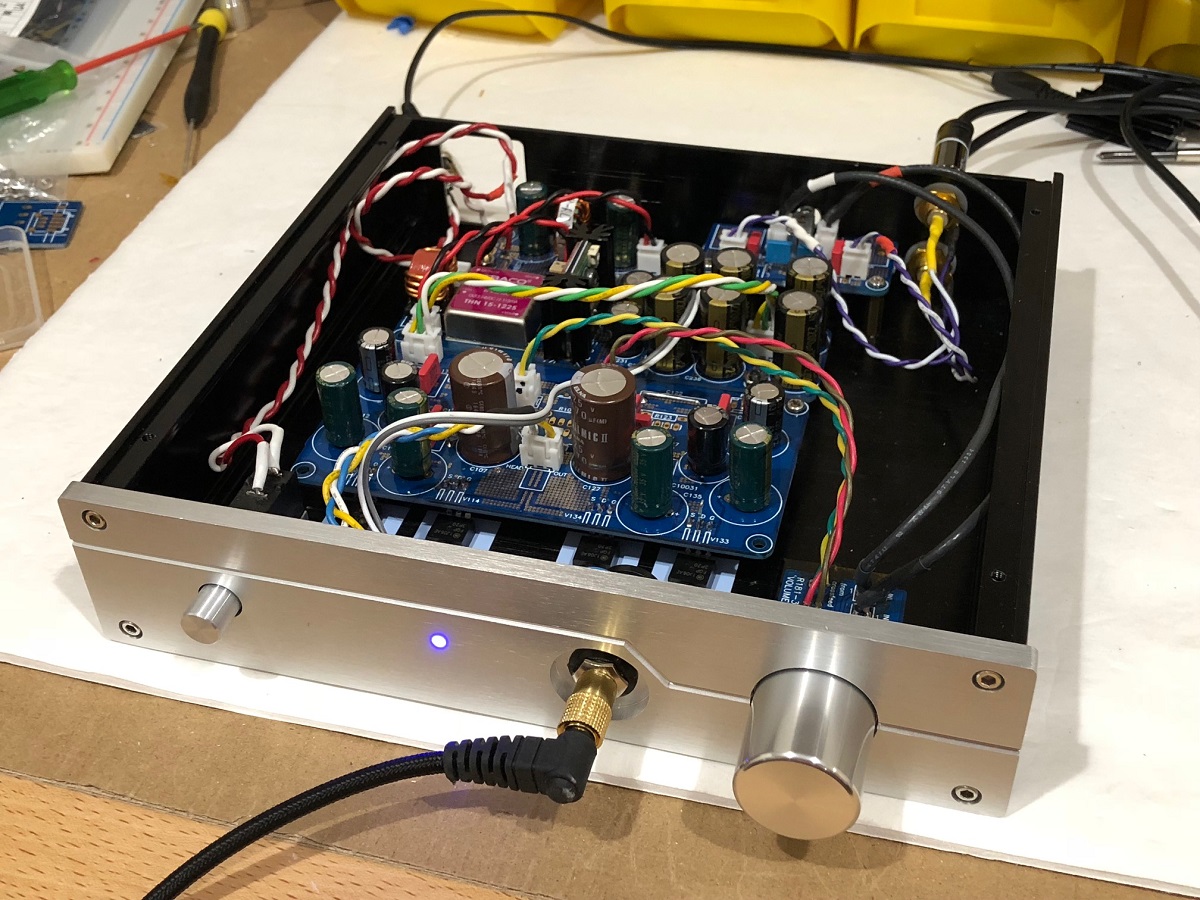
Simple High Performance DC Coupled Class A HPA with sub PPM THD
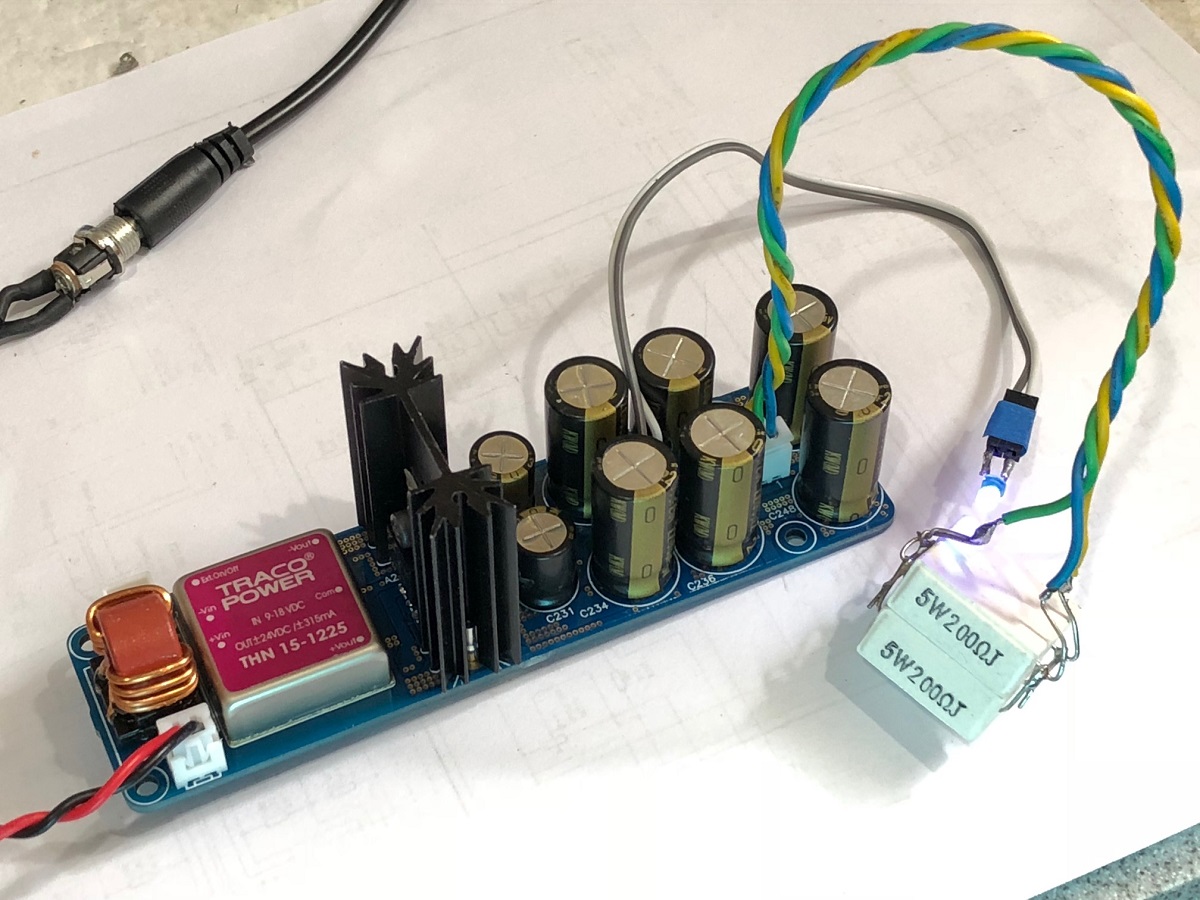

I later swapped the 78xx/79xx regulator for the TPS7A4XXX ones:
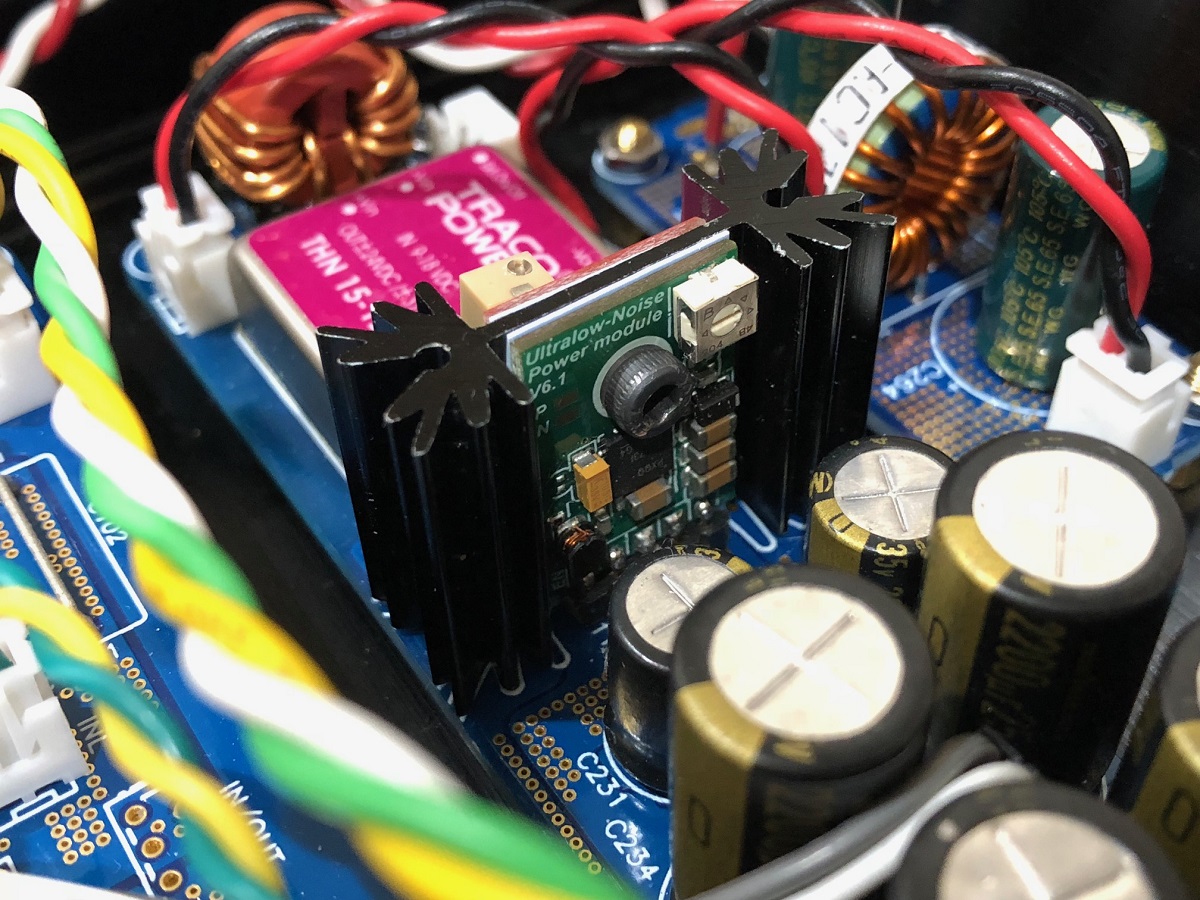
And I believe that to this day, this is the quietest PSU I have ever made or measured. I still wonder if I should have put the cap Mx before the regulators though…
Here is FFT:
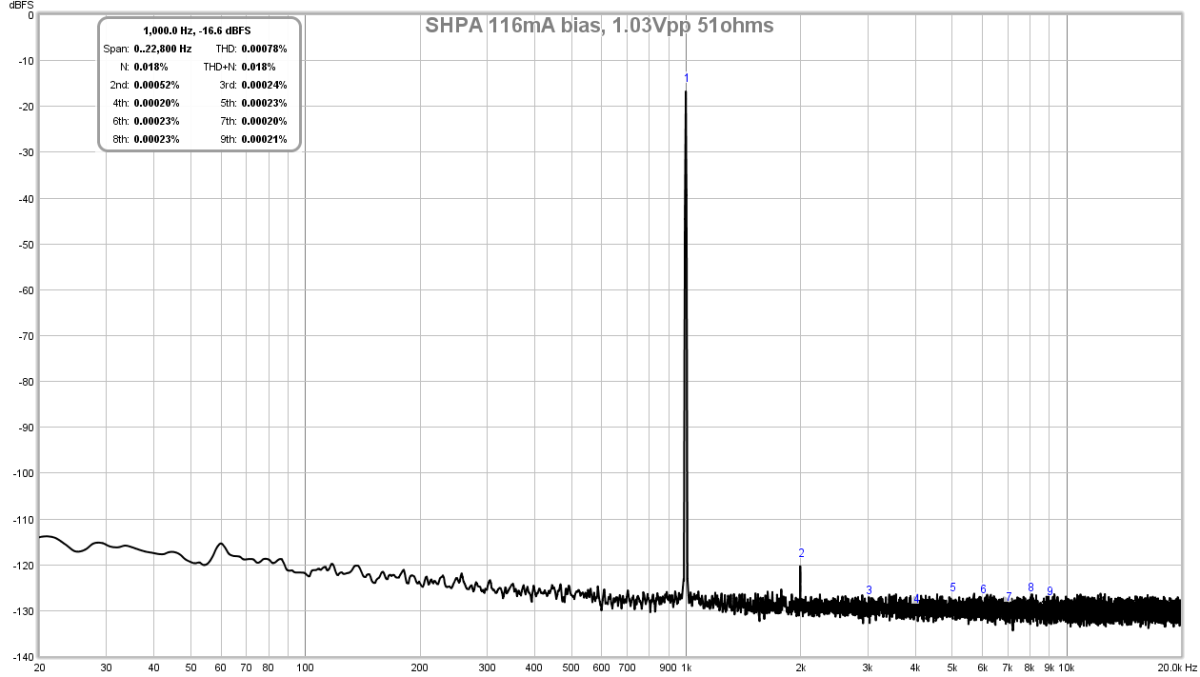
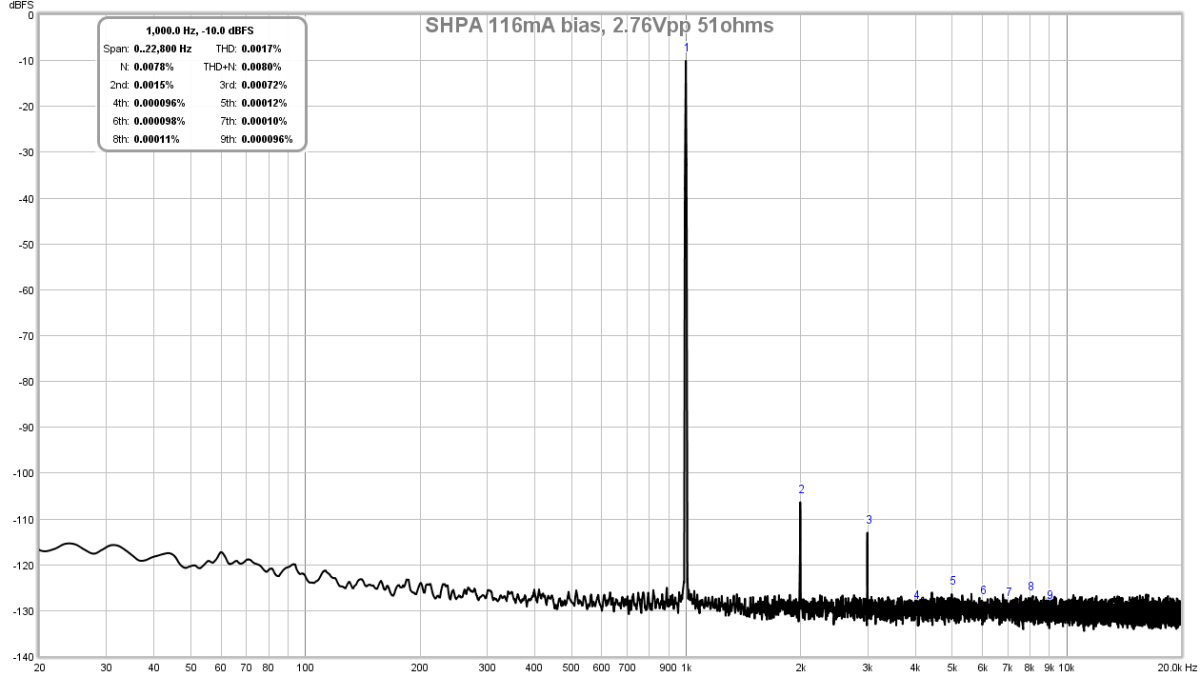
Of course, superb layout by JPS64 is also key to achieving this kind of performance.
Schematic:
https://www.diyaudio.com/forums/att...s-hpa-sub-ppm-thd-hpa-complete_001a_page2-pdf
Here is the amp:
Simple High Performance DC Coupled Class A HPA with sub PPM THD
I later swapped the 78xx/79xx regulator for the TPS7A4XXX ones:
And I believe that to this day, this is the quietest PSU I have ever made or measured. I still wonder if I should have put the cap Mx before the regulators though…
Here is FFT:
Of course, superb layout by JPS64 is also key to achieving this kind of performance.
Schematic:
https://www.diyaudio.com/forums/att...s-hpa-sub-ppm-thd-hpa-complete_001a_page2-pdf
Last edited:
Bimo, that can be solved. if you are into highest performance LT3045 should be tried out. I can arrange a few for you if you like.
For free? 🙂
On my headphone amp I used a 12v linear wall wart supply feeding a Traco +/- 24v DCDC switcher which then went to a TPS7A4XXX low noise regulator. This then fed a mosfet cap Mx and that was then filtered by a CRCRC. I adjusted the regulators to get +/-18v after the cap Mx (circa 4v drop). The result was a supply that was quiet like a battery.
And I believe that to this day, this is the quietest PSU I have ever made or measured. I still wonder if I should have put the cap Mx before the regulators though…
My personal experience with this is installing the Cap Mx before a 78/79xx regulator, which always results in dead-silent regulated supplies.
Since the 78/79 regulators are "fed" from the highly magnified effect of capacitor "multiplication" they run more quietly, even though the actual filter(s) right after the rectifier are not needing to be huge.
A "smallish" 1000uF cap prior to the Mx transistor, with a 100uF on its base, results in something like 10,000 uF that the regulator sees.
Cap multiplier made my 6922 b+ power supply dead silent. It provides 115v from a voltage tripler setup.
There is 4 v p-p on the unfiltered supply at 125v
There is 4 v p-p on the unfiltered supply at 125v
Traco THN15-1225 is not the average switcher. It costs 36 Euro a piece here which is a multiple of what the polluting stuff costs that audio companies deliver with equipment. It still needed excellent linear regs and intensive filtering to make it clean. It is higher cost and simply well designed. Probably even higher cost than designing it completely linear. So the PSU is the exception not the rule. The lack of good switchers is what drove commercial guys to found companies in linear PSU's 🙂
BTW I think the cap multipliers don't make the regulators perform at their best with regards to output impedance, they should have been before the regulators.
BTW I think the cap multipliers don't make the regulators perform at their best with regards to output impedance, they should have been before the regulators.
Last edited:
BTW I think the cap multipliers don't make the regulators perform at their best with regards to output impedance, they should have been before the regulators.
It depend on what kind of capacitance multiplier. If the capacitance multiplier is simple emitter follower or double emitter follower, I agree. But if capacitance multiplier with op-amp or discrete op-amp, the output impedance will be very low.
- Home
- Amplifiers
- Solid State
- Chip regulators vs capacitance multiplier